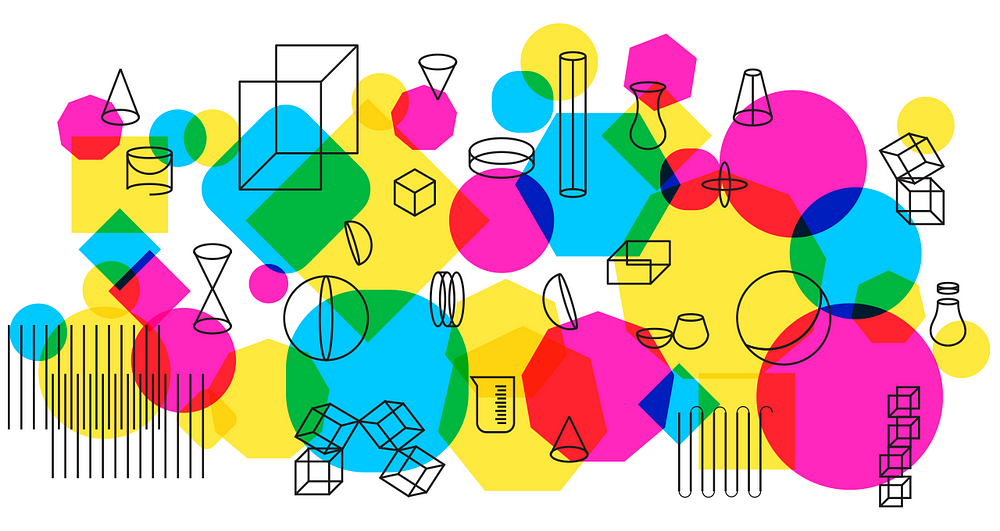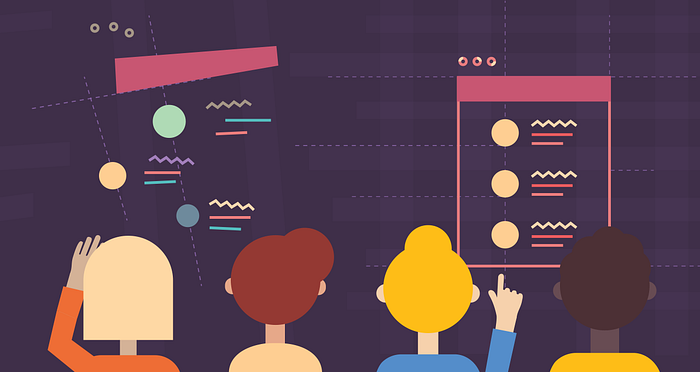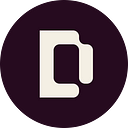
Part 1: Is design for me? And what are my options?
Chances are you landed on this post because: 1) you hate your job, 2) you need a change, and 3) you’re thinking about making design your new career.
If so, congratulations — you’ve already taken the first, and perhaps the hardest, step. You’ve set your heart on a career in design, and you’ve committed to a new, more rewarding professional path.
If, however, you’ve only recently started considering a career change into design, it’s worth taking a bit of time to get familiar with the design profession, to explore the different career paths that are open to you, and to think about whether you might eventually want to specialize in any particular field.
1. What is design?
It’s interesting how we identify the “beginnings” of modern design. The website Online Design Teacher begins its timeline in the Victorian period, around the 1830s. Meanwhile, Design Is History begins in 1450, a period which marked the introduction of printing presses in Europe, and the beginnings of the mechanical reproduction of graphic media. Going further back still, Meggs’ History of Graphic Design (a big book now in its 6th edition) starts its detailed timeline right back at the invention of writing systems, around 15,000 BCE.
In truth, humans have been designing since the dawn of our species. Whether by building bonfires, planting fields of crops, or laying out words on a page, we’ve been solving problems by shaping the form and function of the things around us. As Frieze explain in their article “What Is Design”,
Whenever human beings have tried to change any part of their lives — starting with prehistoric men and women moulding lumps of clay into drinking vessels, or sharpening the heads of spears to make them deadlier weapons — they engaged with design, instinctively and unknowingly.
That’s why, in our day-to-day lives, we have two different common-sense ideas of what design is. One is about aesthetics, or form (“that poster is so nicely designed!”), and the other is about usability, or function (“this tin opener is so badly designed!”)
Designers are problem solvers, who craft both the form and function of a product so that it can effectively fulfill its intended purpose. The design work in demands today is wide-ranging, whether it’s creating album artwork for rock bands, developing smart devices for the home, or designing buttons and interactions for apps and websites like this one.
2. Is design for you?
“Design is not a profession but an attitude.”
László Moholy-Nagy
The first thing to say is — don’t go into design for the money. It’s true that some design careers are in high demand and can be quite lucrative — but to be a successful designer, first and foremost you need to have a real belief in creating product experiences that enhance people’s lives and help solve the problems they face.
Excelling in any field of design requires empathy for users, deep engagement in the process of concept development, prototyping, and testing. It also demands open-mindedness and humility, which will allow you to listen to critique and use it to improve your work. UX designers are valued so highly in the job market (more on that later) precisely because they are trained to bring high levels of value to customers and users. And the value a designer brings is fundamentally in their approach to problem-solving — also called “design thinking”.
If you’re more interested in conventional graphic design, be mindful that you’ll still need an orientation in design thinking and the principles of user-centred design. Even when we’re “only” creating graphic work, for a design to be successful it still needs to respond to the needs of the audience. A good advertising campaign or poster needs to reach the customer in much the same way as a good device or app — by connecting with a need they have, and motivating them to take action.
3. What career paths are available as a designer?
Designers are in high demand. According to John Maeda’s Design In Tech Report 2017, the big tech companies like Google, Facebook and Amazon have increased designer headcount by 65% in the past year alone. Teaching of the design thinking process is also proliferating in business schools, indicating the broader importance of designers’ problem-solving skills to business.
Unsurprisingly, given that almost everything we use each day has been designed in some way, design is also an exceptionally broad and diverse discipline. For new design students or career switchers, this can be a bit disorientating, because there are so many possible directions for study.
To simplify the landscape a little, let’s think of design as an industry formed of these clusters of skills:
- visual/graphic design, logo/brand design
- user experience (UX) design; user interface (UI) design, interaction design (IxD)
- service design
- industrial design, product design, packaging design
- fashion design, costume design, textile design
- furniture design, interior design
According to the Future of Design survey 2016, the top 5 most hired design positions are product designer, brand designer, UX designer, UI designer, and design director (that last one is a senior position within any field of design).
The great news is that there has probably never been a better time to train as a designer. As recently as 5 years ago, design education was still largely delivered offline, restricted mainly to face-to-face courses offered by universities, further education colleges, and private training providers.
But in the past few years, we’ve seen a sharp increase in the number of online providers of design education. Pretty much all price points are now covered, as is a wide range of learning models, ranging from directed reading and video classes through to immersive study and 1-on-1 mentoring. And, of course, these new models of teaching and learning make it possible to retrain without the financial risk and time commitment of enrolling in a traditional design school.
Of the six clusters of disciplines listed above, the first two currently have the best coverage by online providers — partly because these fields are conducive to online learning models, but mainly because there is huge demand from employers for visual, UX and UI designers.
Commercial success is increasingly driven by the quality of a company’s apps and websites. What’s more, there is no sign of this demand fading, as companies compete to innovate and outdo the competition. The careers website Glassdoor estimates that the average salary of a UX designer in the USA is now over $80,000.
4. So what do I need to learn?
The growth of online design education from companies like Designlab hasn’t just added more options for anyone debating how to change careers. Online providers also have the advantage of running an operation with lower overheads, in turn making it a more cost-effective option for students. Other advantages include extra flexibility, global access, and a responsive curriculum that keeps pace with the skills being asked for out in the job market.
As part of any design learning journey, you’ll need to make sure to cover the fundamentals of graphic design, including (but not limited to) these:
- Principles of visual organization — like layout, hierarchy, contrast, and balance.
- Color theory — how to build color palettes and use them sensitively and effectively.
- Typography — the difference between different typefaces (fonts), and how to choose and combine them.
- Design thinking — how to empathise with the user, and think from their perspective to solve problems with visuals and products.
If you’re interested in becoming a user experience (UX), user interface (UI) or product designer, you’ll also want to make sure you get a grounding in the principles behind interface and interaction design. This will help you to build digital products that are both usable and delightful.
What some people fear the most when starting their design training is learning the software. The main thing to remember is that software is only a tool. Your priority should be to learn the design principles above — the technical stuff will follow, and, worst comes to the worst, answers to most questions about how to do something in Illustrator, Photoshop or Sketch are only a Google search away.
Real and deep understanding of the visual, psychological, and philosophical principles behind design, however, can’t be Googled — there is no alternative to learning them, inwardly digesting that new knowledge, and repeatedly applying design principles by working on projects.

5. What are my options for changing careers?
Here are the main options for getting changing careers. Check out the wild difference in prices, relative to traditional design school (the first item in the list below).
i. Traditional art or design school
Pros:
- Depth and historical contextualization of curriculum
- Face-to-face teaching and feedback
- Lots of projects and practice
- “Complete” student community experience
Cons:
- Extremely expensive ($20,000-$100,000)
- Long and slow, taking you out of the job market for several years
- Pathways of study are prescriptive
- Skills taught can be out of step with the job market
ii. Independent study (aka self-teaching or self-study)
Examples:
- Learning through books, tutorials, blog articles
Pros:
- Least expensive option ($10-$150)
- Easily tailored to your own interests
- Take things at your own pace
Cons:
- Can be lonely
- Lack of feedback from peers and teachers
- No deadlines or accountability means it’s easy to get demotivated
- You’re likely to stay in your comfort zone, limiting new skills gained
iii. Video-led online courses
Examples:
- Lynda, Alison, Creativelive, Coursera, Udemy
Pros:
- Inexpensive ($10-$300)
- Easily tailored to your own interests
- Take things at your own pace
- Good quality video content helps you learn and understand new concepts more quickly
Cons:
- Lack of feedback from peers and teachers
- No deadlines or accountability means it’s easy to get demotivated
- Hard to know what courses to take unless you’ve got someone to guide you
- Video content is a very passive way to learn
iv. Video-led online courses combined with project work
Examples:
- Lynda or Alison content where you set yourself mini-projects
- Creativelive, Coursera or Udemy content with bundled exercises or briefs
Pros:
- Inexpensive ($10-$300)
- Easily tailored to your own interests
- Good quality video content helps you learn and understand new concepts more quickly
- Project work gives the opportunity to apply your new skills in a structured way
Cons:
- Lack of expert feedback on your project work
- Hard to understand where and how to improve
- No deadlines or accountability means it’s easy to get demotivated
- Hard to know what courses to take unless you’ve got someone to guide you
v. Project-based online courses with mentoring and peer feedback
Examples:
- Designlab, Careerfoundry, Bloc
Pros:
- Inexpensive ($300-$600 for short courses; $6,000-$9,800 for intensive UX design programs)
- Curated content and custom-built curriculum guides your learning in stages
- 1-on-1 mentoring with practising designers
- Student community, group critiques and peer feedback on work (Designlab only)
- Easy to combine part-time with a day job
Cons:
- Not the same level of student community as with a face-to-face course
vi. Offline (face-to-face)
Examples:
- Designation, General Assembly, Tradecraft, Shillington (graphic design only)
Pros:
- Face-to-face classes
- Immersive course delivery with lots of project briefs
- More hands-on help with learning software tools
Cons:
- Most expensive option ($10,000-$14,000)
- Classroom model can mean less 1-on-1 contact time
- You need to live close to campus
- Can be inflexible — often full-time is the only option
6. Building a library: books (and other stuff) to read
First, check out our list of 12 amazing books to get you started in design!
Next, subscribe to some great design sites. Here are our top picks:
- Invision
- Marvel
- Product Design Weekly
- Creative Review
- UX Design Weekly
- Fast Co Design
- Design Week
- Typewolf
- Prototypr
- Designlab Weekly
- Creative Bloq
- It’s Nice That
- Muzli
- Designer News
- Sidebar
- Web Designer News
- Designboom
Summary — and what’s coming up in Part 2
That’s the end of Part 1 of this mini-series on how to become a designer without going to design school. We discussed what design is, examined how we should understand design’s history, outlined some of the disciplines and career paths available to the aspiring designer, and looked at the main options for getting trained up.
In Part 2, we’ll turn to what happens after you’ve done your training — the process of building a portfolio, identifying and applying for jobs, networking both online and offline, and how to keep your skills up to date. Make sure to sign up to our newsletter so you don’t miss the next installment. You can also follow us on Medium, Facebook and Twitter!
Switch careers with Designlab
You can test the water in your spare time with our introductory short course, Design 101.
It lasts 4 weeks, and you can work on the materials whenever you have time. Each week, you’ll get to meet 1-on-1 with a mentor who works in the industry, and they’ll give feedback on your work and help you improve. Find out more
